The Ultimate Hood River, Oregon Travel Guide
Hemmed between the Oregon and Washington border, this windy water-sports mecca has something for everyone. Add it to your list of adventures worth waiting for.
New perk: Easily find new routes and hidden gems, upcoming running events, and more near you. Your weekly Local Running Newsletter has everything you need to lace up! .
It took me╠řyears╠řto fully appreciate Hood River, the outdoor recreation fairyland╠řjust an hour east of Portland, Oregon. Since moving to Portland in 2010, IÔÇÖve been drawn to the wind-carved canyon╠řof the Columbia River Gorge, the quick access to Mount╠řHoodÔÇÖs year-round snowy runs, and the Hood River areaÔÇÖs abundant apple orchards and vineyards. But it wasnÔÇÖt until 2016, when I made the one-mile crossing over the Columbia from Oregon into the neighboring town of White Salmon╠řin Washington, that I was able to grasp Hood RiverÔÇÖs╠řbeauty;╠řfrom that vantage, it looks like some ancient Swiss mountain villageÔÇövibrant, tree covered, etched into the side of the river gorge, and╠řset against╠řa backdrop of Mount╠řHoodÔÇÖs craggy, 11,240-foot peak.
For the uninitiated, Hood River isnÔÇÖt exactly a mountain town, at roughly an hour by car from its namesake summit. Since the 1980s, itÔÇÖs earned a reputation as one of the worldÔÇÖs premier wind-sport destinations, thanks to its╠řwind-tunnel effect. Warm, dry desert air from eastern Oregon pulls cool, wet weather from the Pacific through the Columbia River Gorge, giving this stretch of river Goldilocks conditions and violent whitecaps. Every summer, brightly colored kiteboards dot the riverÔÇÖs edge. ÔÇťItÔÇÖs a unique dynamic that doesnÔÇÖt exist in many other places in the world,ÔÇŁ explains TJ Gulizia, a wind-sports expert at the Big Winds shop in town.
Forty years after the birth of windsurfing, international diehards and curious tourists still come for gusty thrills. Most visitors, though, are drawn to Hood RiverÔÇÖs proximity to downhill skiing, world-class whitewater, view-filled hikes, and precipitous mountain-biking trails╠řin the gorge and the . The area╠řalso happens to be nestled in the center of OregonÔÇÖs orchard country,╠řwhich produces╠řapples and cherries that will redefine the fruits╠řfor you entirely.
With a slew of new boutique hotels and a blossoming food and drink scene on either side of the Columbia, thereÔÇÖs never been a better time to explore this Portland-adjacent adventure mecca. The biggest challenge when visiting Hood River for the first time, it seems, is knowing where to start.
What You Need to Know Before Visiting
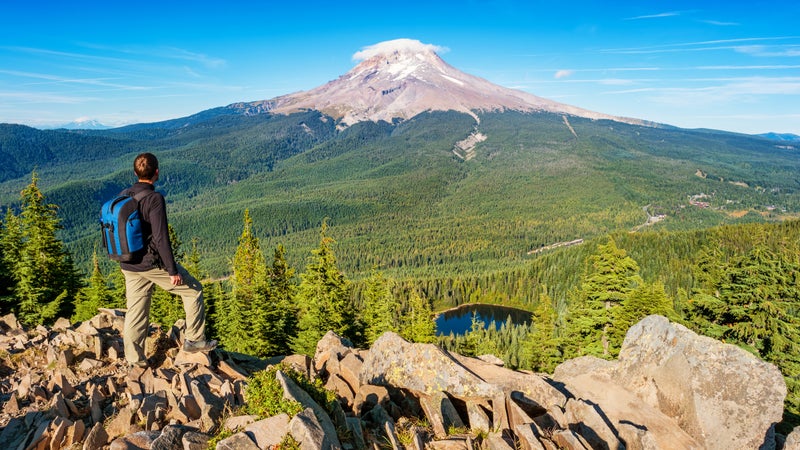
Prepare for the occasional trail closure and hiking permit: Many of the gorgeÔÇÖs most popular trails remain closed for rehabilitation after 2017ÔÇÖs scorched 48,861 acres of forest on the Oregon side of the river. No need to despair: although the waterfall corridor is a crowd-pleaser, it makes up only a small fraction of the 293,000-acre╠řColumbia River Gorge National Scenic Area. If youÔÇÖre headed west from Hood River into the╠řcorridor, check the of fire-affected trails. ║┌┴¤│ď╣¤═° the burn area, one of the gorgeÔÇÖs buzziest treksÔÇönearby Dog MountainÔÇörequires a during peak wildflower season on weekends╠řfrom April to June.
Watch for ice: Hood RiverÔÇÖs steady westerly gusts are a double-edged sword for travelers during the shoulder season and winter months. Locals are easily identifiable by their studded snow tires, and for good reason: the combination of heavy precipitation, just-around-freezing temperatures, and intense winds can turn Hood River and its main artery, Interstate 84, into an ice rink. Visit╠řthe╠ř╠řbeforehand.
Take a shuttle: You donÔÇÖt need to find your way through peak summer traffic, thanks to (CAT) next-level public transportation. It offers shuttles from Portland to Hood River, with multiple stops in the gorge and free winter trips from Hood River to , one of the areaÔÇÖs biggest downhill ski areas.
How to Get There
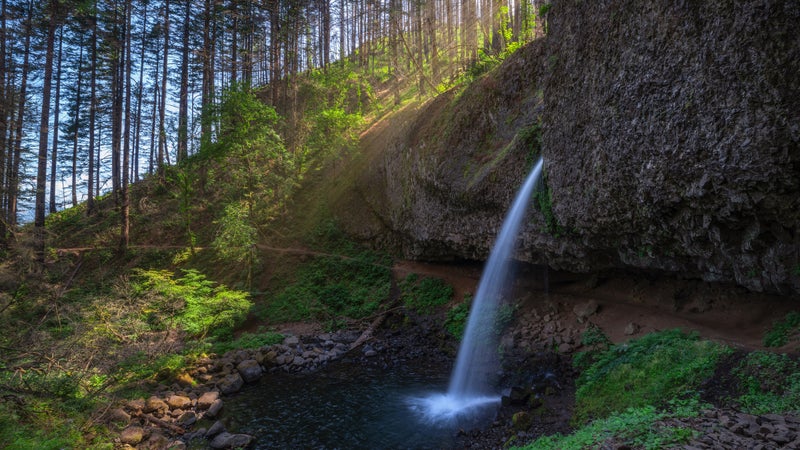
The vast majority of visitors drive east from Portland╠řon I-84, which runs along the border between Oregon╠řand Washington. The one-hour╠řtrip takes you through the Columbia River Gorge National Scenic Area╠řand past the stateÔÇÖs most impressive waterfalls, from Multnomah to╠řWahkeena.
WhatÔÇÖs the Best Time of Year to Visit Hood River?
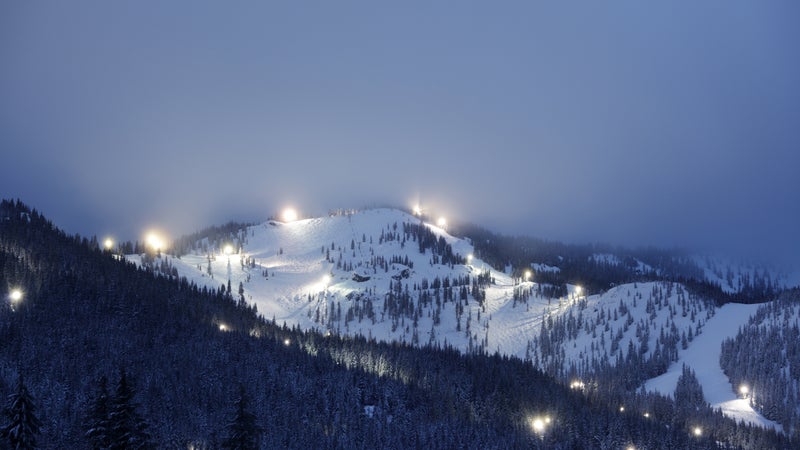
Summer: This is prime time for the area, when average daytime highs hover in the low eighties, meaning╠řyou can wear nothing but swim trunks or a bathing suit╠řwhile windsurfing or paddleboarding. Mount Hood, meanwhile, typically thaws out by early August, opening up a wealth of high-alpine backpacking and mountain-biking trails. That said, youÔÇÖll still find plenty of snow atop Palmer Glacier at ÔÇöone of North AmericaÔÇÖs only year-round ski areas. The rub, of course, is that everyone else is out there with you. Expect heavy traffic en route to╠řand around the mountain.
Fall: ThereÔÇÖs a sweet spot in September when the crowds thin and before the weather turns. Expect temperatures ranging from the forties╠řat night up to the seventies╠řduring the day. A major bonus is the , a 35-mile scenic drive through farmland and forests when produce is at its ripest, with endless acres of apple orchards containing heirloom varieties╠řfrom Arkansas Black to Northern Spy.
Winter: In-the-know powder hounds use Hood River as their home base between December and March.╠řTypically, thereÔÇÖs minimal traffic on the way up to╠řthe mountain on bucolic Route 35╠řcoming from Hood River, especially compared to the daily jam that clogs Highway╠ř26, which runs╠řdirectly from Portland to Mount╠řHood. Regardless of the weather, always bring chains in the winter╠řif you donÔÇÖt have snow tires.
Spring: Even if itÔÇÖs pouring in Portland on a spring day, itÔÇÖs likely youÔÇÖll find reliable sunshine in Hood River and eastward,╠řthanks to Mount HoodÔÇÖs rain-shadow effect: prevailing winds rise, cool, and condense in the form of rain (or snow) on one side of the mountain, leaving dry, warm air on the opposite side. March through May is peak wildflower season in the gorge, and the╠ř3.5-mile Mosier Plateau, four-mile Dalles Mountain Ranch, and five-mile Lyle Cherry Orchard Trails all put on stunning displays of lupine, paintbrush, and phlox, just to name a few.
Where to Stay in Hood River
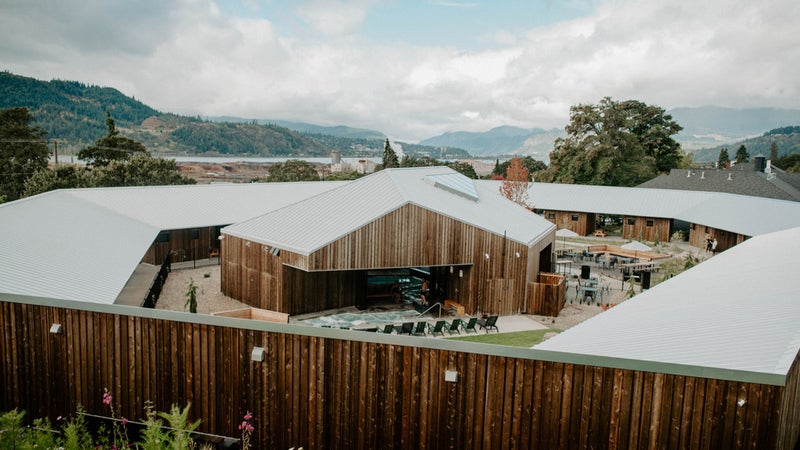
The past few years have seen a wave of redesigned hotels in the area. The circa-1912 (from $99), located downtown, got a retro-chic face-lift in 2017 from the team behind PortlandÔÇÖs swanky . Exclusive perks include the 420 in the Gorge╠řpackage, a partnership with neighboring cannabis dispensary , and an in-house outpost of PortlandÔÇÖs popular Scandinavian-brunch restaurant . Across the river, the╠ř╠řis a transformed╠ř80-year-old schoolhouse. It now boasts╠řa thrifty outdoor clubhouse with communal bunk rooms ($45) and a small settlement of cabins (from $159) encircling a sprawling spa and bathhouse. Warm and cold pools, a sauna, a fresh-juice caf├ę, and an underground meditation room known as the Sanctuary are free to guests.
For a more agrarian experience, (from $225), just seven miles south of Hood River, is a luxurious farm stay with five rooms, 30 acres of pear and apple orchards, 20 beehives, grazing sheep, and perfect mountain views. Those wanting to car-camp close to Hood River can pitch a tent near the Columbia at Viento State Park (from $17), eight miles west of town, or right along Hood RiverÔÇÖs namesake at Tucker Park ($25), six miles south.
What to Do While YouÔÇÖre There
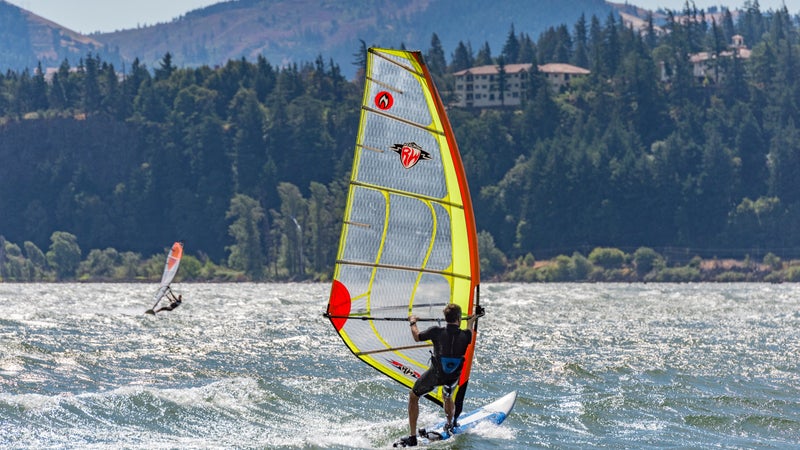
Wind Sports
ThereÔÇÖs a reason Hood River hosts the ÔÇÖ╠řBoard Sports Expo every year and is the home base of some of the biggest names in wind sportsÔÇöitÔÇÖs the ideal place to be hauled across the water by nothing but a stiff breeze. For those still mystified by the wind-sports industry, hereÔÇÖs a brief history: the 1990s were all about windsurfing,╠řthe early 2000s saw the advent of kiteboarding, and╠řkite and wind foiling kicked off in the 2010s, allowing riders to levitate above the water at faster speeds than were previously possible due to╠řa╠řfinlike hydrofoil jutting beneath the board. YouÔÇÖll find every permutation of wind sports still thriving in Hood River today, but wing foiling (utilizing an inflatable, handheld detached ÔÇťwingÔÇŁ) is the current industry darling.
For plucky first-timers, , one of five outfitters perched on the edge of the Columbia, offers lessons (from $49) in nearly every iteration of the niche sport that╠řyou can imagine, from mellow stand-up paddleboarding to cutting-edge wing foiling. Those starting out will likely practice inside ÔÇťthe hookÔÇŁ just off the main promenade. Veterans packing their own gear will quickly discover that the best wind isnÔÇÖt directly in front of Hood River╠řbut four miles west on the Washington side at the Hatchery. For a detailed lay of the land, check in with any of the rental shops, outfitters, and guides lined along the waterfront.
Whitewater Rafting and Kayaking
A massive confluence of designated Wild and Scenic Rivers, from the Salmon to the Klickitat, flows through this section of Oregon and Washington. Several outfitters operate out of White Salmon, one mile north of Hood River. A local favorite, , offers trips in both states, including a full-day Class IIIÔÇôIV roller-coaster rafting adventure for kids and adults on the White Salmon River (from $140) that ends╠řwith a 12-foot nose dive down Husum Falls.
Hiking
Hood River is a short distance from dozens of view-gifting gorge hikes. , a two-mile loop, is an easy option across the river and excellent for wildflower spotting╠řin the spring, while the 12.2-mile╠řround-trip and 2.6-mile routes╠řare both heart-pumping straight shots up to dramatic cliff panoramas. Driving westward back toward╠řPortland gives you access to the famed waterfall corridor╠ř(though be aware of possible trail closures), from the much Instagrammed Multnomah Falls to OneontaÔÇÖs narrow, one-mile basalt wade, both of which have trailheads just off the highway.
In summer, the entirety of Mount╠řHoodÔÇÖs alpine trail system is open. The mountainÔÇÖs east-side treks are most accessible from Hood River. , a six-mile round trip hike,╠řgains up to 5,120 feet in elevation╠řand╠řtakes you through an old-growth Douglas fir forest and across glacial streams right up to HoodÔÇÖs craggy face, which looms over an aster- and parnassus-strewn meadow. For a shorter, year-round jaunt only 30 minutes from Hood River, hike the 3.4-mile╠řout-and-back , a wide cascade that flows from Cold Spring Creek over a 110-foot lava cliff. The backpacking possibilities in this national forest are endless, from an 8.5-mile round-trip day hike to Bald Butte╠řto the bucket-list , a 40-mile, round-the-mountain loop offering jaw-dropping scenery in all directions.
Mountain Biking
Blame the occasional windless day for the cityÔÇÖs endemic mountain-biking scene. ÔÇťIn the old days when there was no wind, we would just hang out in the parking lot and not know what to do,ÔÇŁ explains Tim Mixon, president of , a volunteer-based organization responsible for building and tending to many of the areaÔÇÖs mountain-bike trail networks. ÔÇťAs trail building and bike design have kind of merged to where 50-year-old guys like me can go ride with 20-year-olds, itÔÇÖs just exploded around here.ÔÇŁ
, a nearly 40-mile network of trails with up to╠ř3,400 feet of vertical descent╠řfrom╠řthe Seven Streams staging area to the berm-filled╠řsegment of╠řBorderline, is the holy grail of mountain biking in Hood River. From spring through fall, riders of all skill levels and styles can explore routes that range from labyrinthine cross-country╠řtrails╠ř(Spaghetti Factory) to precipitous downhill sections (Dirt Surfer). Sixteen miles south of Hood River sits , the largest╠řnetwork of singletrack in the region, and just across the river╠řin Washington╠řare the wide-open, boulder-strewn╠ř system and the wildflower-abundant Nestor Peak ride╠ř(a 12-mile out-and-back). hosts╠řtours╠ř(from $100)╠řled by guides with encyclopedic intel of the area, while a tune-up at downtown is a great excuse for a breakfast-burrito break at neighboring .
Skiing and Snowboarding
There are three main players on Mount Hood when it comes to downhill snow sports, each with its strengths and flaws. , a wood and iron fortress, is the only ski-in, ski-out resort on the mountain. ItÔÇÖs╠řalso known by out-of-town visitors as the filming location for Stanley KubrickÔÇÖs The Shining. At 8,540 feet, Timberline╠řis the╠řhighest serviced ski area in the region and╠řnearly guaranteed to be snow covered year-round ($72 for a day pass). Closest to Portland on Route 26, is prized for being both steep and cheap. Runs are comparatively short, but with the largest collection of black diamonds in the state and 34 floodlit night runs, itÔÇÖs a steal at $53 for an adult day pass.
Finally, on the southeastern side of the mountain, (from $82 for a day pass) is a Goliath best suited for those with a ÔÇťbigger is betterÔÇŁ mentality. It features╠ř2,150 skiable acres, six high-speed quads, a three-mile-long run, and 2,777 feet of vertical drop. Be prepared for regularly icy conditions. Those who have little ones in tow can opt for smaller runs and smaller╠řcrowds at either , on the north side of the mountain, or , right inside Government Camp, which is a glorified bunny hill and the second-oldest continuously operating ski area in the country.
The Best Places to Eat and Drink in Hood River╠ř
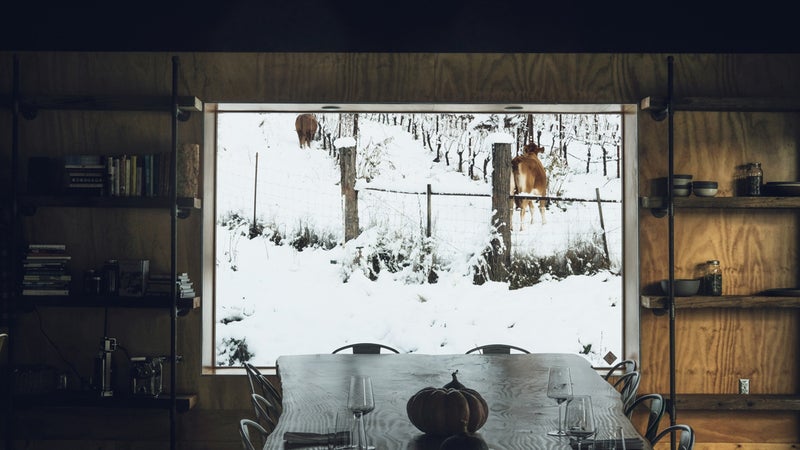
Between top-notch access to produce, a serious wine scene, and influence from PortlandÔÇÖs scrappy, forward-thinking chefs, Hood River has become a veritable dining destination. The aforementioned Broder ├śst, located in the Hood River Hotel, offers up photogenic Swedish hash, cardamom-scented fika pastries, and Norwegian potato crepes╠řwithout the lines youÔÇÖll find at its Portland outposts. Then thereÔÇÖs , an Italian eatery with hyper-local leanings, and , a wood-fired pizzeria, two longtime╠řstalwarts with heavily seasonal influences.
Hood River is a heavyweight beer city in an already beer-obsessed state,╠řwith breweries like O.G. , established in 1987 and known for its amber ale, and╠ř, a modern titan of craft beer thatÔÇÖs won nearly every industry award and accolade. , which opened in 2018 a few doors down, serves IPAs and Czech lagers alongside kombucha brewed with sencha, Assam, and oolong teas.
Five miles southwest of Hood River, has made a name for itself in recent years as one of the most exciting, high-end wine-tasting experiences in the Pacific Northwest. Nate Ready, a former sommelier for NapaÔÇÖs , grows 80 different grape varietals on his 30-acre biodynamic vineyard thatÔÇÖs maintained only by grazing pigs, cows, and chickens. It all comes together in a tasting room where funky, raw vintages meet piperade-coated house sausages.
In the town of White Salmon, the╠ř is known for its chewy, tangy loaves exclusively made with flour from small-scale Pacific Northwest mills in its custom-built wood oven. Poppy spelt and fig-barley bread make for exceptional sandwiches, toasts, and tartines, while an onslaught of pastries╠řfrom╠řcroissants to polenta cake╠řtake full advantage of the regionÔÇÖs glut of fresh berries and stone fruits.
If You Have Time for a Detour
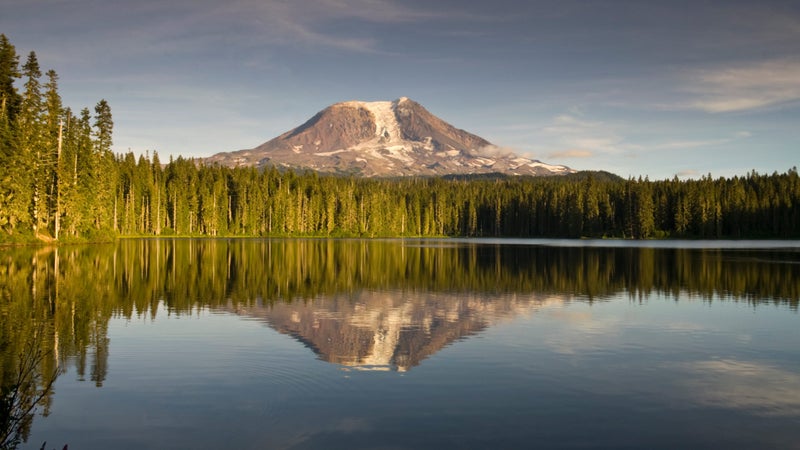
If youÔÇÖre vehement about avoiding crowds╠řor in search of wild, alpine wilderness sans ski lifts, the , just an hour north of Hood River in Washington, is home to one of the more magnificent glaciated peaks in the Pacific Northwest. The second-tallest mountain in the state at 12,281 feet, Mount╠řAdams sits a good distance from both Portland and Seattle, making it relatively secluded, even in the summertime. Make your base camp , a 53-site campground (from $18) whose╠řswimming hole often acts as a pristine mirror for Adams, looming just seven miles away. For a quick, up-close encounter with the peak, hike the steep, 2.6-mile round-trip , which winds around a tight, rocky spire to an old fire-lookout-tower platform.
For backpackers, instead of attempting the five-day circumnavigation that combines the Round the Mountain, Pacific Crest, and╠ř╠řTrails (not to mention╠řa treacherous bushwhack and glacier traverse), opt for , an easy overnight trip with many of the longer routeÔÇÖs best qualities. This╠řten-miler along the mountainÔÇÖs north face offers stunning sights (and wildflowers in July and August) as you ascend up to Foggy Flat, a grassy expanse perched below Lyman Glacier. Mountaineers flock to Mount╠řAdamsÔÇÖs╠ř, a nontechnical 12-mile round-trip assault. From╠řMay to September, most climbers make their summit attempt over two days, stopping at the relatively flat, boulder-strewn Lunch Counter on the first night. The final two-mile leg up to the summit affords╠řincredible views╠řof WashingtonÔÇÖs five volcanoes.
How to Be a Conscious Visitor╠ř
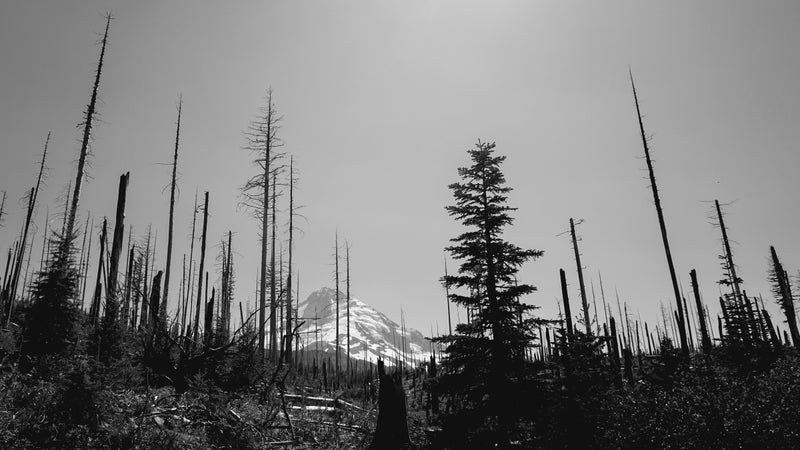
For anyone who didnÔÇÖt experience the emotional and environmental devastation of the 2017 Eagle Creek Fire, Rachel Pawlitz, the Forest Service public-affairs officer for the Columbia River Gorge, likes to remind visitors that despite the regionÔÇÖs reputation as soggy and moss covered, summers are ÔÇťinherently quite dry, starting in late June.ÔÇŁ The baseline is,╠řÔÇťif you donÔÇÖt need a fire in the summer, donÔÇÖt set one,ÔÇŁ says Pawlitz. If you do happen to encounter╠řearly signs of forest fire and have cell-phone reception, call 911 and report the fire, she says. ÔÇťIf itÔÇÖs already been reported, authorities might be able to give you more information on where to go next,ÔÇŁ she adds. ÔÇťItÔÇÖs important to hike with a map and compass so you can╠řlook for an alternative route that can get you back to your car.ÔÇŁ For more local safety tips, .
